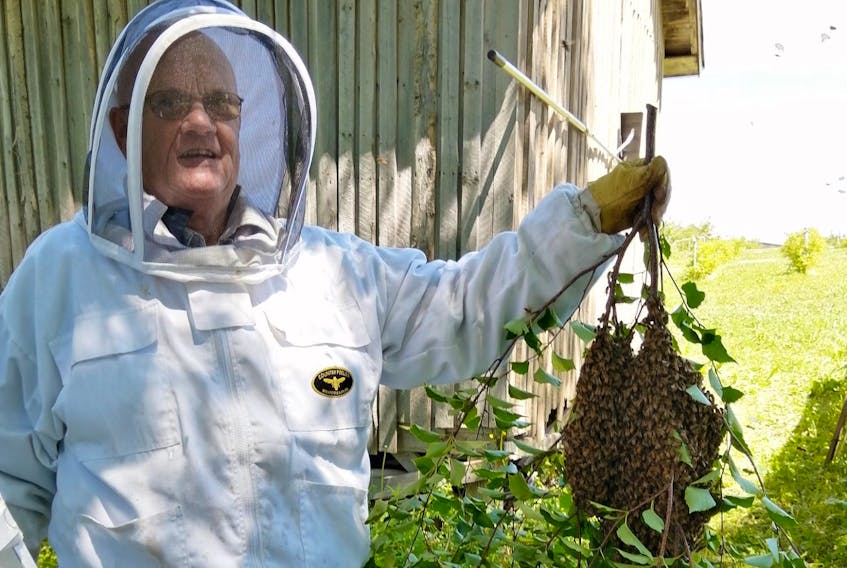CORMACK, N.L. — A colony of bees has likely taken up residence in an old or abandoned structure in Cormack and their owners want people to be on the lookout and not to be concerned about their presence.
Dawn Stack and Lee Harvey say the bees are not likely to cause people any trouble as long as people don’t bother them. Stack and Lee are the owners of the Cormack Bee Company Ltd.
Lee started keeping bees on their Cormack property as a hobby and to help pollinate the raspberry plants they have. They officially registered their bee business last year and have more than 200,000 bees in five full colonies and four beginner colonies.
Last week, close to 50,000 bees escaped from one of the hives. Stack said there are two hives that are close together and they had just finished inspecting one and moved on to the next one.
“When I had heard all this buzzing.”
It wasn’t normal and she knew it wasn’t coming from the hive they were working on. She looked up to see a swarm of bees getting ready to make itself into a ball in a tree.
The couple and their new employee had been out working in the heat all morning and decided to take a break. They’ve had experiences with a swarm before and from talking with their bee mentor in New Brunswick, they figured they had some time.
“We didn’t get to get up in the tree and get it quick enough,” said Stack, because when they came out a half-hour later the bees were gone. “They have their own minds,” she said.
They looked around their immediate area for the bees, but so far have had no luck in finding them.
“They’ve probably found some spot to permanently stay by now,” said Stack. “It’s got to be a place that’s enclosed that they can fill with the bees to draw out the honey.”

The bees were full of honey at the time and swarming can happen when there’s no room for them to drop the honey in the hive.
Harvey said they had recently made some changes to the frames they use in order to free up space for the queen to lay her eggs, but believes it wasn’t soon enough to prevent the swarm.
“They naturally swarm and once they get in that mode to swarm you can’t stop them,” he said.
There are a few tricks that can be used to try to trick the queen, but they’re not always successful. Once the swarm forms, scout bees will go out to find a new home for the colony, and when they do, they’ll return and communicate the location with the swarm. The range they travel to do so is generally less than 10 kilometres.
“They only need an inch hole to get into, but there’s got to be a cavity behind for them to work. They were gone fairly quickly, so I’m thinking that those scout bees didn’t get too far. I’m hoping,” said Stack.
It’s been too hot for the bees to be out much, so when things cool down a bit Stack and Harvey will take a look around the back roads and meadows and some abandoned structures for the colony.
“Wherever they’re pitched they’re not going to go anywhere else. They found their home and it’s no trouble to spot them." — Lee Harvey
In the meantime, they’ve posted about the loss on Facebook as a way to educate the public and hopefully find the colony. To sweeten the deal, they’re offering a $50 reward to anyone who helps them locate the colony.
“Generally, the public doesn’t know the difference between a wasp and a honey bee,” said Harvey. “Bumblebees yes, but these honey bees they don’t look like a bumblebee and if you saw one you would probably think it’s a wasp.”
The bees only present a danger to people if they are threatened so he advises people not to try to deal with them themselves.
“Wherever they’re pitched they’re not going to go anywhere else. They found their home and it’s no trouble to spot them. On a good sunny day, you’ll see a lot of bees out right around wherever they’re pitched.”
Anyone who sees the Cormack bees should contact the company.
“Just don’t go doing anything trying to disturb them, because they’re quite content to be left alone to their own devices,” said Stack.
She said they would try to retrieve them if at all possible because it’s unlikely they would make it through the winter unless they’re in a really secluded and well-protected area from the cold.
Twitter: @WS_DianeCrocker









